The thread junkie in me is bubbling to the surface again!
Today, it’s bubbling up to show you a new-to-me silk thread that I’ve had a chance to play with recently. It’s Sajou’s Fil Au Chinois silk perle #30, and it’s… lovely. Deep Sigh.
Well, it’s silk – so what can I say?
I can’t resist trying new-to-me threads, examining them closely and seeing what they’re all about. I got these particular threads from Needle in a Haystack, where they’re newly listed on their website here.
If you’re a crazy quilter, a needlepointer, a cross stitcher, or a surface embroiderer, you’ll find plenty of good uses for a silk thread like this. It’s the kind of thread that’s hard to resist. It’s got a great sheen, it feels good, and, with a few little technical tips, it stitches up beautifully!
Let’s take a close look at it!

Fil Au Chinois Silk Perle #30, which I’m going to refer to hereafter as Sajou’s silk perle, is available in a small range of 30 colors that are fairly classic, with a few bright, trendy colors in the mix, too.
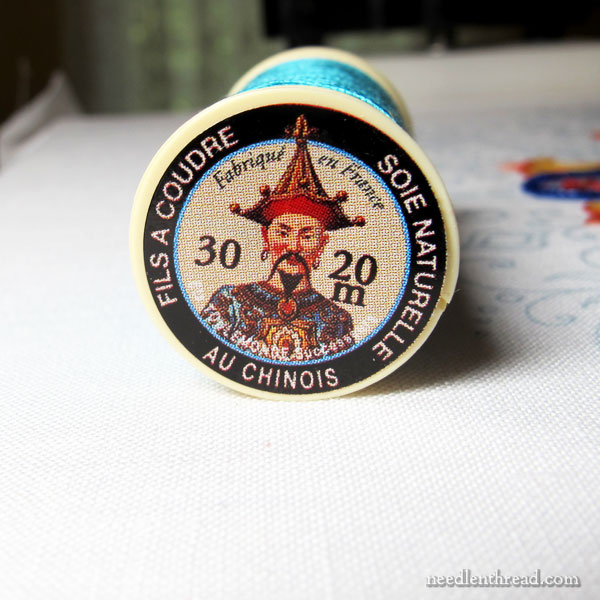
The thread comes on 20 meter spools. They’re nice-sized spools which have, as is typical of Sajou, a kind of vintage look to them.
The Fil a Chinois label has a bit of a history to it. You can read about it on the Sajou website, here. In fact, the Sajou blog (Madame Sajou’s Diary) is terrific to read and has lots of nice tips and ideas on it, if you’re looking for a generally fun browse.
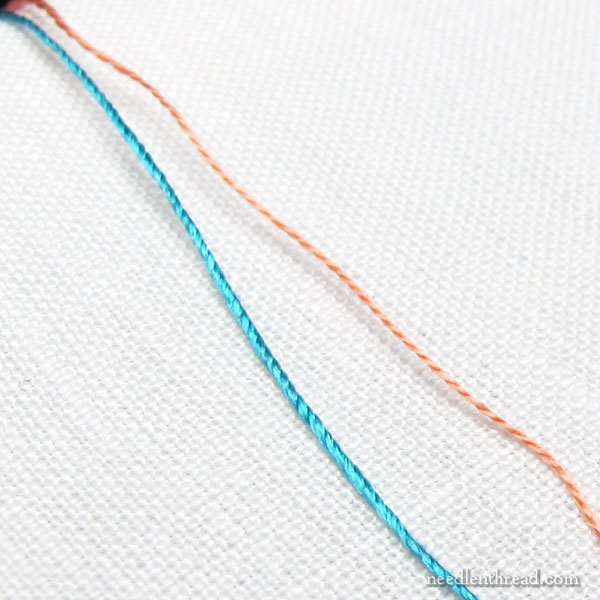
To give you an idea of the weight of the thread, here it is (in turquoise) lined up next to one strand of DMC cotton (in peach).
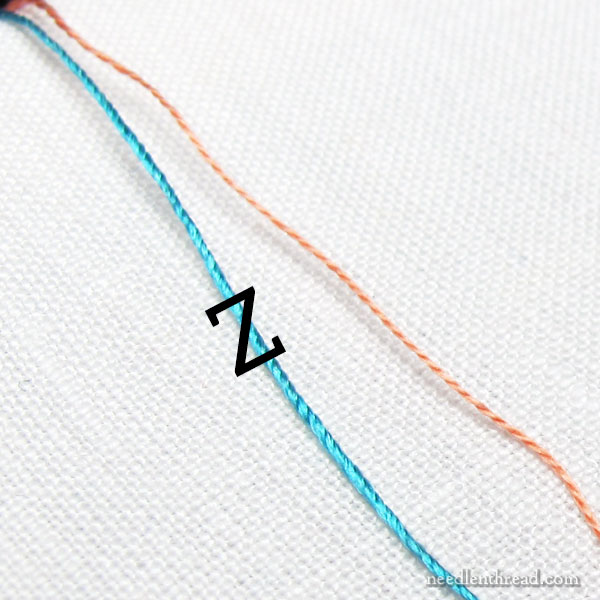
Sajou’s silk perle is a z-twisted, 3-ply filament silk.
In a nutshell, the z-twist is important to know about because it requires a different approach on some embroidery stitches. Most common hand embroidery threads – cottons, stranded spun silks, for example – are s-twisted, and most embroidery instructions are written assuming the use of s-twisted threads.If you’re not familiar with the difference between s-twisted threads and z-twisted threads, you can read about the differences in the following articles:
S-Twisted vs Z-Twisted Threads
S-Twisted vs Z-Twisted Threads, Stitched
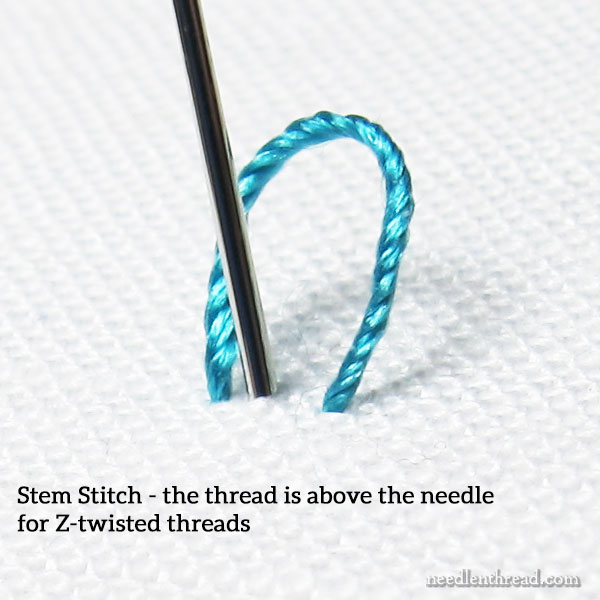
The biggest difference between s-twisted threads (like typical cotton embroidery floss) and z-twisted threads (like some silks and pretty much all rayons) is found in stitches that are meant to twist together, like stem stitch, or in stitches that require winding the thread around the needle multiple times, like bullion knots.
With the stem stitch, when stitching from left to right, the working thread is normally kept below the needle when you’re stitching with cotton. That’s how most people do stem stitch. But with a z-twisted thread like this silk perle, if I want to maintain the ropey look of the stem stitch, I have to work it from left to right with the working thread above the needle.
In any case, if you don’t use rayons or silks like these, the point it rather moot. You don’t need to worry about z-twist and s-twist. But if you’re venturing into new types of threads, it’s worth paying attention to the twist of the thread.
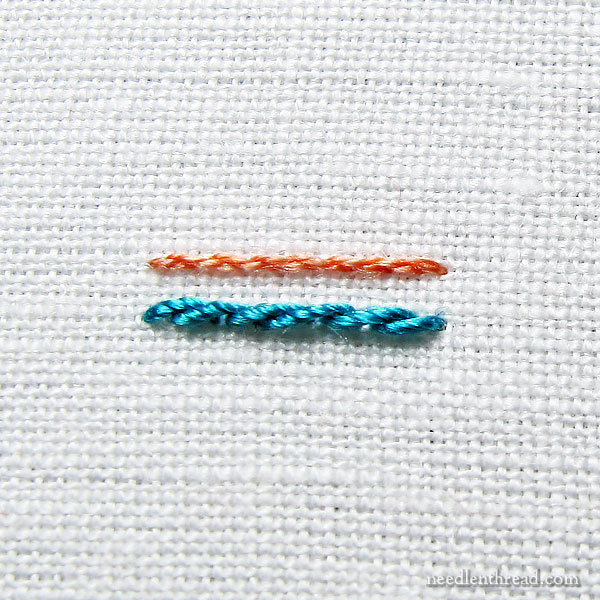
To give you a clear idea of the weight of this silk, the top line is stem stitch in one strand of DMC floss (taken from the six). And on the bottom is a line of stem stitch worked with the silk perle.
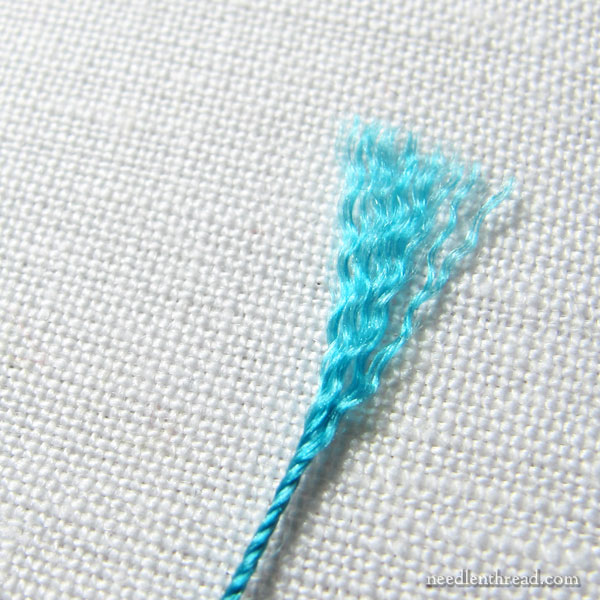
Incidentally, because Sajou’s silk perle is filament silk, it can be taken apart and used, since strands of filament silk are very strong and don’t really need a twist to keep their strength intact.
However, taking apart this type of thread can be amazingly fiddly! When taken apart, the thread will have a definite wave to it, as you can see in the photo above, due to the twist. Sometimes, you can play with that to get some interesting effects in stitching. But again – super fiddly!
Compared to Soie Perlee
Sajou’s silk perle lines up in type and weight quite near to Au Ver a Soie’s Soie Perlee. Soie Perlee comes on smaller spools of 14 meters, but they have a much more extensive color range and the spools are priced comparable to the amount of thread on them.
If you want to read more about Soie Perlee, I covered it in this article on Twisted Filament Silks.
Where to Find It
So, if you’re a thread junkie like me and you want to give this silk perle a try, here’s where you can find it:
If you’re in the States, you can find Fil a Chinois silk perle #30 through Needle in a Haystack.
I don’t know of any other shop carrying the Sajou silk threads in the US, but if you know of any, let me know! If you’re looking for other Sajou goodies in the US, you’ll find Sajou charts and kits available through French Needle, here.
Overseas, you can find Sajou threads directly through Sajou in France, if you don’t have a local store that carries them.
Looking for More Thread Talk?
If you get excited about embroidery threads, if you want to know more about different types of hand embroidery threads available on the market today, or you’re a thread junkie, too, and just want to read about threads in general, you’ll find plenty of other articles about embroidery threads here on Needle ‘n Thread. Have a browse!
Hope you enjoy your weekend and get in plenty of time with your needle and thread!







That really is a beautiful thread Mary, I can see why you are enjoying using it so much! The difference between S & Z twist is fascinating also. It’s not something I’ve had to deal with before although I have recently bought a few skeins of the Rajmahal rayon art silks for the Home Sweet Home project. Would these be an example of a Z twist thread? If they are, I will be referring back to this article when I start using them! 🙂
I’m so glad you reviewed Sajou’s Silk Perle #30! I have been contemplating ordering some but I wasn’t sure it was as thin a thread as what I need (and it doesn’t look like it is). Incidentally, when I was sourcing it, I found them on Etsy http://etsy.me/2qFKcWi
Do you know if these silks are washable/colourfast?
Hi, Margaret – I haven’t tried washing them. You could probably contact the folks at Sajou to see what they say, though I have found that most commercial silk like this (as opposed to overdyed) is “somewhat” colorfast, as long as it isn’t washed in hot water, it isn’t ironed when wet, and as long as steam isn’t used if ironing. It always pays to test a thread first, no matter what the manufacturer says about colorfastness!
Must be my sewing background…threads on spools make me happy!
Those spools in those lovely colors look so yummy. I thought it was interesting that the spools seemed to have notches for holding the thread we well as the channels. Or am I seeing things? I have never embroidered with silk thread, but recently was able to pick up some Kreinik silk threads on clearance at Joann Fabrics. 20 half skeins in colors that I could easy use for stitching some flowers, stems and leaves. I think it will be a good introduction for me. I will have to go check out the other colors available for the Sajou perle threads.
Yes, that’s right. There are notches and there are the channels in the head of the spool.
The reels are so cute too! I’ve used these threads as a gimp thread in bobbin lace. I found them online at Australian Needle Arts here in Oz.
Mary, was wondering what you thought about the “Straw Silk Thread” I told you about
in my comment yesterday????????
Nancy
Hi, Nancy – Thanks for your comment! I’ve scoured all my comments to find one from yesterday, with a question about straw silk, but there isn’t one. Perhaps you didn’t hit the submit button after writing it? I can’t find it anywhere! Did you leave it on the website, or email it in?
Thanks so much for the share. It made my day to know that I am not the only thread junkie 🙂 May need to go play with some of my threads now….
I recently found this thread ‘Straw Silk’ by Silk Road Fibers. They sent me a sample to try and loved it. It kind of looks like straw but feels like silk but works up really nice and gives a different look than floss. I played with it with all stands and than just one strand and it works up very dainty and cute. I do a lot of crazy quilt miniatures and this will work really nice. Also what I found is it is hand dyed and lovely difference in color when stitched. Have you run across this thread?? Needle in a Haystack carries it. Don’t remember but come in many colors. If you haven’t heard of it wanted to give you heads up so you might try it. Always looking for different and unusual to make my pieces different. Would like to know what you think of it if you get to try it. Thanks Nancy
Hi, Nancy – I’ve not heard of it, but it sounds like an interesting thread. Is it stiffer like straw? I’ll have to look it up!
No soft like silk
I mostly use silk thread for applique. I love the feel of it and it disappears into the fabric. My favourite colours are in the green and blue hues and a off white neutral. Most of my appliques are of leaves, stems and flowers, so I do like a few reds.
OMG!! These silk threads look as if they are so soft to the touch… I’m dying to touch something embroidered with it.
Great article! Have you tried maison sajou’s rayon thread? How does it compare to others, like Madeira or mettler’s poly sheen? Thanks!